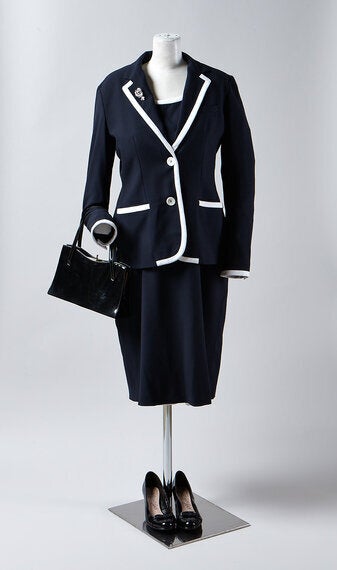
Costume designed for Meryl Streep in 'The Iron Lady', 2011.
The big new exhibition at the Southbank Centre in London "History is Now" http://www.southbankcentre.co.uk/whatson/history-is-now-7-artists-take-88866 is meant to address British postwar history. It does not do so. As a Scot who voted 'No' in the referendum I found the experience of visiting this show profoundly depressing. I left with an increased sense that a 'British' identity has become problematic, dislocated and fragile, and that the ties that bind the countries that make up the Union are coming undone.
The exhibition takes as its starting point a book on English social history, and basically changes 'English' to British'. There is nothing in the exhibition at all about Scotland or the relationship between England, Wales and Scotland. There is a nod to Northern Ireland in the shape of an exhibit about "the Troubles" but with little context.
What is Britain? What does it mean to be British? Surely, the answer must involve the four countries, their peoples linked by kinship, history and culture, which are currently its constituent parts. That status is threatened by the rise of Scottish Nationalism and the decline of a sense of Britishness. In the part of the archipelago we call 'Scotland' - which makes up about a third of the land mass http://www.ons.gov.uk/ons/rel/regional-trends/region-and-country-profiles/key-statistics-and-profiles---august-2012/key-statistics---scotland--august-2012.html - the notion of 'British' identity is pulled so taut and thin that it threatens to break. This is a historical moment of vital importance for Britain. The referendum result was No but the nationalist movement has not gone away.
I imagined that an exhibition at the heart of the British capital about British social history and identity would attempt to address this - or to at least to acknowledge it. This exhibition is part of the Southbank Centre's "Changing Britain" Festival which runs right up to the hotly contested general election, where the Scottish National Party hopes to do better than ever before. http://www.heraldscotland.com/politics/wider-political-news/poll-snp-on-course-to-take-kennedys-seat-but-not-jim-murphys.119952690
There is obviously an intention to be inclusive in some senses - all of the three event weekends planned at the centre feature migration stories. But there is not even a nod towards Scotland, or towards the changes that devolution has wrought in that period.
Seven artists were invited to create collections that reflect postwar British history: all but one live and work in London (the exception is Berlin). No Scots were invited to contribute. No Nathan Coley or Douglas Gordon, no Alison Watt, or Jim Lambie, no Karla Black or Susan Philipsz, no Richard Wright or Martin Boyce.
It's true that within the individually curated collections, if you look very carefully you may identify a couple of pieces by artists with links to Scotland: there is a collage by Scots-Italian artist Eduardo Paolozzi and the five-minute video dance film 'Pace', funded by the Arts Council of England, is in fact by Scot Katrina McPherson. But there is no explicit reference to Scotland anywhere at all. Not a stick of rock, not a saltire, not even a train ticket. What then, is Scotland's place in British post-war history?
I was left wondering if the artistic director of the Southbank Centre Jude Kelly or the curator of the Hayward Gallery Cliff Lauson or any of the seven artists they chose have ever even travelled north of the border. When they think of 'Britain' they presumably think of London and the south east with a kind of amorphous blob of 'north' added on.
If Britain has any long-term future, we will need to find a 'British' identity that works for the future. There is a real possibility otherwise that the union will shatter and leave three or four separate countries. People who believe that Britain could and should have a future look to the custodians of great national institutions to work towards synthesizing the parts into a whole that makes sense. In this case, I think they have failed us.
"History is Now" at the Hayward Gallery ends April 26. The "Changing Britain" Festival at the Southbank Centre runs until May 10.
This article first appeared on Jackie Kemp's website, www.jackiekemp.scot.